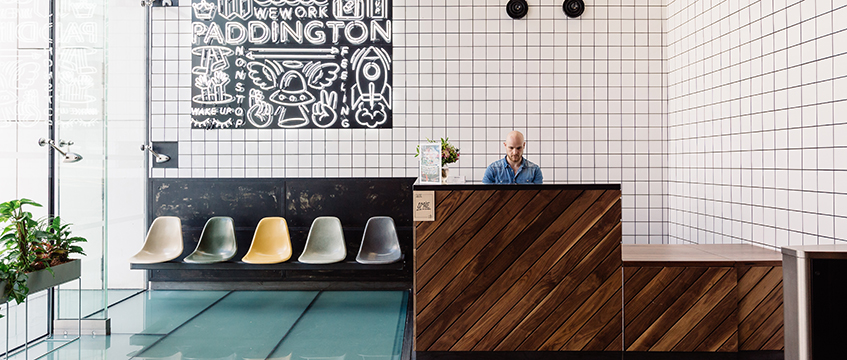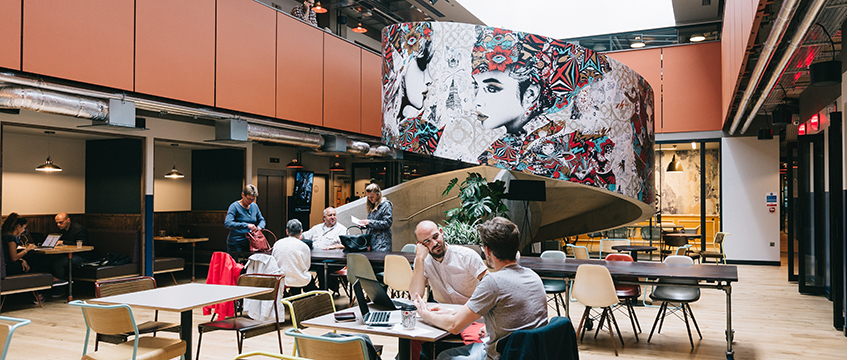WeWork is London’s most talked-about occupier. Having become the capital’s largest commercial tenant at the start of the year, everyone is asking whether it is here to stay or whether it will crash and burn in the face of a market slowdown.
Founded eight years ago in New York by Adam Neumann and Miguel McKelvey, WeWork has expanded its flexible office service to 65 cities in 345 locations worldwide.
It has also embarked on an acquisition spree in the past two years, that just last month saw it take Chinese co-working start up Naked Hub and UK office design and fit-out firm LTB. New York-based private coding academy Flatrion school is also part of its portfolio.
The brand has expanded to include WeLive, which offers communal housing, fitness space provider Rise by We and this year will open its first private elementary school, WeGrow, in New York.
So what do you need to know about the fast-moving company?
1. It’s expanding fast – really fast
WeWork reported that as of 1 March it had 220,000 members, an increase of 108,000 since May 2017, representing a 69% growth in membership over 10 months.
Eighteen months ago, WeWork had just five or six buildings in London where it was offering its flexible office space. Now it has 33 locations, putting the capital second only to New York. Globally, WeWork is adding between 500,000 sq ft and 1m sq ft of new space every month.
In the UK WeWork opened its second Manchester location, at St Peter’s Square, at the beginning of May, and is looking to try to expand its first Manchester location, at No.1 Spinningfields, where it has three floors of the 24-storey tower.
Most of this expansion was kickstarted by a $4.4bn (£3.2bn) investment from Softbank last year.
Matthew Brown, WeWork senior director – real estate, European expansion, said at CBRE’s London Market Insight Series that the company is in a period of “hyper-growth”.

2. Funders don’t care that the company is making a loss
At the end of April, WeWork went to the debt market with a seven-year bond offer, originally targeting $500m (£368m). It raised $702m (£516m), a 40% increase on its initial target.
Brown said going to the debt market was a strategic decision, as the company has the “first mover advantage in growing and scaling and the market indicated to us a desire to invest in us or to provide that debt.”
This is despite the revelation in the bond issuance documentation that the company made a $933m loss last year on a doubled-up revenue of $866m, and concerns that rent-free periods coming to an end may start to pinch.
However, in just a few days since its debut on the bond market, the price of WeWork’s bonds has fallen. Issued at $1, the price of the bonds stood at 96.2 cents on 3 May. WeWork issued its seven-year unsecured bonds at a yield of 7.9%.
The move into the debt market follows the investment from Softbank and other companies such as Goldman Sachs.
3. WeWork says Trump and Brexit have been a boost
Corporations across the globe are searching for ways to lower their total square footage to cut costs and run their businesses more efficiently. The uncertainty created by tumultuous political and economic events across the globe has also made companies wary of letting more space on traditional leases.
“The election of president Trump or Brexit for example drove huge enquiries to our business as people sought to protect against this 15- or 20-year lease commitment they may have been forced to sign up to and instead seek flexibility with us,” Brown has said.
WeWork claims that it saves its enterprise clients between 25% to 50% in operating expenses.
Its average square footage per person hovers at around 50 sq ft compared to the 250 sq ft per person allocated in more traditional commercial office layouts.
However, despite the small footprint, WeWork members pay an average $6,928 (£5,099) per year, with the company capturing a healthy 30-40% operating margin.
London has the most expensive membership fees at an average $574 (£422) per hot desk and $1,130 (£832) for a private office, which is 20% higher than New York’s at an average $435 (£320) for a hot desk and $943 (£694) for a private office.
4. It is tweaking its strategy to guard against a downturn
WeWork is taking steps to reduce its overhead risks and diversify its business model, including pursuing larger corporate occupiers, shifting from leases to co-management deals where possible and lengthening member lease terms.
It is also starting to build up its own property portfolio, acquiring 51 Eastcheap, EC3, for around £48m and 120 Moorgate, EC2, for around £40m last year and taking a 10% stake in the £580m acquisition of Devonshire Square, EC2 from Blackstone in April.
It has also been highly acquisitive, buying firms involved in architecture and construction to bolster its in-house design team, a move that looks to already be paying off. According to its bond offering documents WeWork’s construction costs per desk declined by 22% in 2017, falling to $5,631 (£4,144).
Brown has said he is not worried by the possibility of a downturn.
“Truthfully we are a very, very organised company in respect to that [a downturn]. We underwrite very conservatively, enabling us to have flexibility in prices in a downturn,” he said.
“As you’ll be aware we‘re in hyper-growth, but we also have tremendous amounts of variable cost that can be effectively cut away in a downturn. So the actual operational underwriting of each unit or each location as we call them, needs to stand alone. The fundamentals are: is it a good building, is it in a desirable location, will it work on its own. And we stick to those principles.
“I’ve done a lot of deals in the past 18 months, but I could have done three times as many had myself and my committee in New York not been as strict. We will walk away from a deal unless it hits our required thresholds.”
5. It wants to dominate the buildings it occupies
According to Brown, he was previously too responsive to the view of landlords that the WeWork model worked best as a small element of the overall occupancy of a building. This is something he says changed during his negotiations with Mike Hussey, chief executive of Almacantar, over taking space at Southbank Place, EC2 where Brown had been conditioned into only looking at letting the ground floor.
“He didn’t really speak to me much or look at me. He walked around WeWork, pontificated for a little bit and then told me I couldn’t have the bottom floor he was building because our business was scalable and would improve with scale, and I had to take the whole thing.
“I learnt from that and now if I see a good building and it’s a good building in a small bit it’s going to be a good building for the whole thing. Its scalable, it makes sense. I believe what will be proven to you in time is that where I have the whole building the vacancy rate will be lower, the desk churn rate will increase. Its more desirable when I control the whole building. Where I control the whole experience it’s better for everyone, and that’s what I’ve learnt.”
■ More on flexible workspace – Blackstone: Fools are entering co-working too late
To send feedback, e-mail Louise.Dransfield@egi.co.uk or tweet @DransfieldL or @estatesgazette











